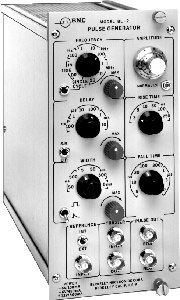
BNC Model BL-2
Fast Tail Pulse Generator
Specifications
Fast, Linear, Stable
Features
- 5 ns Minimum Width
- 3 ns Minimum Rise Time
- Double Pulse Capability
- Adjustable Rise and Decay Times
- Repetition Rates up to 50 MHz
The Model BL-2 is a versatile, tail pulse generator capable of simulating
the outputs from a wide range of detectors, photomultiplier tubes, and related
electronics. It offers good linearity and stability, and fast, narrow pulse
capability. Having a broad range of rise and decay times, the Model BL-2
can simulate the shorter pulses of plastic scintillators and lead glass
as well as the longer pulses of NaI, many liquid scintillators, and amplifier
outputs. The Model BL-2 enables the user to check electronics for linearity,
resolution, rise time effects, count rate effects, and overload effects.
Of particular interest to those that wish to check pulse pair resolution
and count rate effects is that
the BL-2 can operate in a double-pulse mode, with a pair of pulses having
an adjustable separation that can be as low as 10 ns. Since repetition rates
are variable to 50 MHz, a 100 MHz repetition rate is possible by double
pulsing. The high repetition rates enable the user to quickly accumulate
the large number of counts needed for good statistics.
Other features include an:
- External Reference input, where an incoming signal controls the output
pulse amplitude
- External Trigger mode, where an incoming pulse triggers an output
pulse
- External Drive mode, where an in coming pulse controls both output
pulse width and timing.
Specifications
Frequency
- Internal: 10 Hz to 50 MHz, continuously adjustable with coarse and
fine controls.
- External Trigger: 1 V positive pulse triggers a pulse (single or double),
with internal delay and width controls operative.
- External Drive: 1 V positive pulse generates an output pulse with
a width equal to the width of the incoming pulse, internal delay and width
controls are inoperative.
- Single Cycle: One pulse occurs each time the pushbutton is depressed
.
Delay
Single/Double Pulse
Width
Trigger Input/Drive
Trigger Out
Output Amplitude
Polarity
Internal/External Reference
Rise Time (10-90%)
Decay Time Constant(100-37%)
Power Requirements
Mechanical
Weight
www.berkeleynucleonics.com

